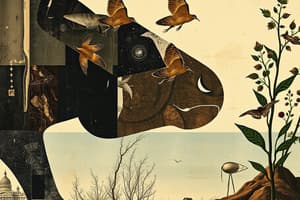Podcast
Questions and Answers
Which of the following best describes an adaptation?
Which of the following best describes an adaptation?
- An inherited characteristic that helps an organism survive and reproduce in its environment. (correct)
- An interaction between living and non-living things in a particular environment.
- A learned behavior that helps an organism survive and reproduce in its environment.
- A place where interactions between living and non-living things occur.
What is an ecosystem?
What is an ecosystem?
- A specific location where organisms live.
- The study of interactions between living and non-living things.
- The interactions between living and non-living things in a particular environment. (correct)
- A place where interactions between living and non-living things occur.
How do scientists study ecosystems?
How do scientists study ecosystems?
- By studying all organisms and parts within a place all the time.
- By studying the interactions between living and non-living things.
- By studying only a small aspect of an ecosystem and then piecing together the overall picture with other scientists. (correct)
- By studying the adjustments organisms make to survive in a place.
What is symbiosis?
What is symbiosis?
How do adaptations help organisms survive?
How do adaptations help organisms survive?
Flashcards are hidden until you start studying
Study Notes
Adaptation
- An adaptation is a trait or characteristic that helps an organism survive and reproduce in its environment.
- Adaptations can be physical, such as the shape of a bird's beak, or behavioral, such as migration patterns.
Ecosystem
- An ecosystem is a community of living organisms (plants, animals, and microbes) and non-living components (air, water, soil) that interact with each other in a specific environment.
- Ecosystems can be small, such as a pond, or large, such as a desert or a coral reef.
Studying Ecosystems
- Scientists study ecosystems through observation, experimentation, and modeling.
- They examine the relationships between organisms and their environment, and the flow of energy and nutrients through the ecosystem.
Symbiosis
- Symbiosis is a close, long-term relationship between different species, in which one or both species benefit.
- There are three types of symbiosis: mutualism (both species benefit), commensalism (one species benefits, the other is not affected), and parasitism (one species benefits, the other is harmed).
Adaptations and Survival
- Adaptations help organisms survive by enabling them to obtain food, avoid predators, and cope with environmental stressors such as temperature and drought.
- Adaptations can also enhance an organism's ability to reproduce, increasing its chances of passing on its traits to its offspring.
Studying That Suits You
Use AI to generate personalized quizzes and flashcards to suit your learning preferences.




